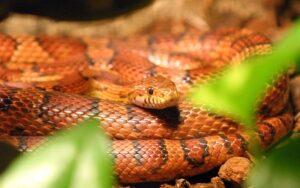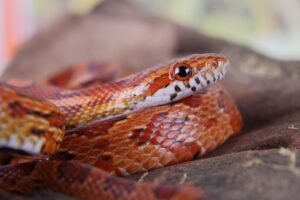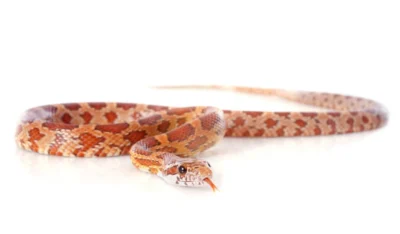Can a corn snake eat crickets? Corn snakes are known for their diverse diet in captivity, which includes a variety of prey items. Crickets are commonly offered to corn snakes as part of their diet due to their nutritional value and availability.
Yes, corn snakes can eat crickets. Crickets are a suitable and commonly offered food item for corn snakes in captivity. They provide a good source of protein and nutrients necessary for the snake’s health and growth. When feeding crickets to corn snakes, it’s important to ensure they are appropriately sized to prevent choking or other digestive issues.
Offering a varied diet that includes other prey items such as mice or rats is also recommended to provide a balanced nutritional intake for the snake. Overall, crickets are a popular choice among snake owners as part of a varied and nutritious diet for corn snakes.
Feeding Preferences of Corn Snakes

Corn snakes are opportunistic feeders with a diverse diet in their natural habitat and in captivity. Here are some key aspects of their feeding preferences:
- Wild Diet: In the wild, corn snakes primarily feed on small rodents such as mice, voles, and occasionally birds. They are skilled hunters and use their keen sense of smell and heat-sensing abilities to locate prey.
- Captivity Diet: In captivity, corn snakes are commonly fed rodents, including mice and rats. These are typically offered frozen-thawed to ensure safety and to prevent injuries to the snake.
- Variety: While rodents are the staple diet, corn snakes benefit from a varied diet. This can include other small mammals, birds, and reptiles, as well as insects such as crickets, mealworms, and occasionally small fish.
- Feeding Frequency: Young corn snakes may eat more frequently (every 5-7 days), while adults can go longer between meals (every 7-10 days or longer). The frequency also depends on the size and age of the snake.
- Prey Size: Prey size should be appropriate for the snake’s age and size. Offering prey that is too large can cause digestive issues, while prey that is too small may not provide adequate nutrition.
- Feeding Behavior: Corn snakes are typically ambush predators, striking quickly and constricting their prey before consuming it whole. After feeding, they may retreat to a secure location to digest their meal.
Understanding these feeding preferences helps ensure the health and well-being of corn snakes in captivity. Providing a varied diet that mimics their natural feeding habits contributes to their overall nutrition and enrichment.
Can Corn Snakes Eat Crickets?
Yes, corn snakes can eat crickets. Crickets are a suitable prey option for corn snakes, especially younger snakes or those that prefer smaller prey items. Crickets are commonly fed to corn snakes in captivity due to their availability, nutritional value, and the fact that they stimulate natural hunting behaviors.
When feeding crickets to corn snakes, it’s important to consider the following:
- Size: Choose crickets that are appropriately sized for the snake. Generally, crickets should be no wider than the snake’s widest part to avoid choking or difficulty in swallowing.
- Nutritional Value: Crickets are a good source of protein and other nutrients that contribute to the overall health of corn snakes. They provide variety in the diet, which can be beneficial for the snake’s well-being.
- Feeding Method: Crickets can be offered alive or pre-killed, depending on the preference of the snake and the owner. Live crickets may stimulate natural hunting instincts, but care should be taken to ensure the snake is not injured during feeding.
- Supplementation: It’s essential to supplement the crickets with calcium and vitamin D3 to ensure the snake receives adequate nutrition, especially if the crickets are the primary source of food.
In addition, crickets can be a healthy and enriching part of a varied diet for corn snakes in captivity. They should be offered alongside other prey items like rodents to provide a balanced nutritional intake and promote natural feeding behaviors.
Nutritional Value of Crickets to corn snakes
Crickets offer a range of nutritional benefits, making them a popular choice as prey for various reptiles, including corn snakes. Here are some key aspects of the nutritional value of crickets:
- Protein: Crickets are rich in protein, which is essential for growth, muscle development, and overall health in reptiles like corn snakes. Protein provides the building blocks for tissues and helps support metabolic functions.
- Fat: Crickets contain moderate levels of fat, which is important for providing energy to reptiles. However, the fat content in crickets can vary depending on their diet and age.
- Calcium: Crickets are a good source of calcium, which is crucial for maintaining strong bones and preventing metabolic bone disease (MBD) in reptiles. Calcium is particularly important for growing juvenile snakes and gravid (pregnant) females.
- Phosphorus: They also provide phosphorus, which works in conjunction with calcium to maintain bone health and other physiological functions.
- Vitamins and Minerals: Crickets contain various vitamins and minerals essential for reptile health, including vitamin B12, vitamin A, vitamin E, and iron.
- Water Content: Crickets have a relatively high water content, which can help maintain hydration in reptiles, especially when they are consuming whole prey items.
To maximize the nutritional benefit of crickets for corn snakes, it’s important to gut-load (feed nutritious foods to the crickets before offering them to the snake) and dust them with calcium and vitamin supplements.
This ensures that the snake receives a balanced diet that meets its nutritional requirements for optimal health and growth.
Feeding Considerations
When feeding corn snakes, several important considerations ensure their health and well-being:
- Prey Size: Choose prey items that are appropriately sized for the snake’s age and size. The prey should be no wider than the widest part of the snake’s body to prevent choking or regurgitation.
- Variety: Offer a varied diet to provide balanced nutrition. While rodents (mice and rats) are the mainstay, include other prey items like chicks, quail, and occasionally insects such as crickets or mealworms to mimic their natural diet diversity.
- Feeding Schedule: Adjust feeding frequency based on the snake’s age, size, and metabolism. Juvenile corn snakes may eat every 5-7 days, while adults can be fed every 7-10 days or less frequently. Avoid overfeeding, which can lead to obesity and health issues.
- Feeding Method: Offer pre-killed prey whenever possible to minimize the risk of injury to the snake during feeding. Some snakes may prefer live prey to stimulate natural hunting behaviors, but ensure supervision to prevent injuries to the snake.
- Nutritional Supplements: Dust prey items with calcium and vitamin D3 supplements regularly, especially if the diet primarily consists of rodents. This helps prevent calcium deficiency and metabolic bone disease (MBD).
- Hydration: Provide access to fresh water at all times, although corn snakes typically obtain most of their hydration from their prey. Ensure water bowls are cleaned regularly to maintain hygiene.
- Monitor Health: Watch for signs of overfeeding, underfeeding, or any health issues such as regurgitation, weight loss, or abnormal behaviors. Adjust feeding practices as needed based on the snake’s response and condition.
By considering these feeding considerations, snake owners can ensure their corn snakes receive a balanced and nutritious diet that supports their health, growth, and natural behaviors effectively.
Potential Risks or Concerns

While feeding corn snakes is generally straightforward, there are several potential risks and concerns to be aware of:
- Feeding Prey Size: Offering prey that is too large can lead to choking, regurgitation, or digestive blockages. It’s crucial to match the size of the prey to the size of the snake, ensuring it can swallow the prey comfortably.
- Feeding Live Prey: Live prey can pose risks such as injury to the snake if the prey fights back. Always supervise feedings if live prey is used, and be prepared to intervene if necessary to protect the snake.
- Nutritional Imbalances: A diet that lacks variety or isn’t properly supplemented can lead to nutritional deficiencies. This is particularly true if the snake primarily consumes rodents without additional prey items or supplements like calcium and vitamins.
- Obesity: Overfeeding, especially with high-fat prey items or feeding too frequently, can lead to obesity in corn snakes. Obesity increases the risk of health problems such as fatty liver disease and reduced lifespan.
- Regurgitation: Stress, improper temperatures, or handling too soon after feeding can cause snakes to regurgitate their meals. This can lead to dehydration, loss of nutrients, and potential health issues if it happens frequently.
- Parasites and Pathogens: Wild-caught prey or prey from unreliable sources may carry parasites or pathogens that can infect the snake. Always source prey from reputable suppliers and consider quarantining new arrivals before feeding.
- Aggression during Feeding: Some snakes may become defensive or aggressive during feeding, especially if they are hungry or perceive a threat. Use caution and avoid unnecessary disturbances during feeding time.
- Metabolic Bone Disease (MBD): Inadequate calcium supplementation or improper UVB lighting (if applicable) can lead to MBD, which affects the snake’s bone health and overall well-being.
- Hygiene and Cleanliness: Ensure that feeding equipment and habitats are kept clean to prevent bacterial contamination, which can lead to infections or digestive issues.
By understanding and addressing these potential risks or concerns, snake owners can provide a safe and healthy feeding regimen for their corn snakes, promoting optimal growth, nutrition, and overall well-being. Regular monitoring and adjustments to feeding practices based on the snake’s behavior and condition are essential for maintaining its health in captivity.
Alternatives to Crickets
There are several alternatives to crickets that can be fed to corn snakes, offering variety in their diet and ensuring nutritional balance. Here are some common alternatives:
- Dubia Roaches: Dubia roaches are a popular feeder insect for reptiles due to their high protein content and relatively low fat content. They are easy to digest and provide a good source of nutrition for corn snakes.
- Mealworms: Mealworms are another option that can be fed to corn snakes. They are readily available, easy to handle, and can be offered alive or pre-killed depending on the snake’s preference.
- Waxworms: Waxworms are high in fat and are often used as a treat rather than a staple diet item. They can be useful for encouraging feeding in picky or stressed snakes, but should be fed sparingly due to their high-fat content.
- Silkworms: Silkworms are soft-bodied and high in protein, making them a nutritious option for corn snakes. They are typically available seasonally and can be fed alive or pre-killed.
- Frozen/Thawed Rodents: Frozen rodents such as mice and rats are the primary staple diet for corn snakes. They are convenient, easy to store, and come in various sizes to suit different snake sizes and feeding schedules.
- Chicks/Quail: For larger or adult corn snakes, chicks or quail can be offered as part of a varied diet. These prey items provide additional nutrients and can stimulate natural hunting behaviors.
- Fish: Some snake owners offer small fish, such as feeder fish or small freshwater fish, as occasional treats. These can be a good source of nutrients like omega-3 fatty acids.
When choosing alternatives to crickets, it’s important to consider the nutritional content of each prey item and ensure they are appropriately sized for the snake. Variety in the diet helps provide a balanced nutritional intake and can stimulate natural feeding behaviors in captive corn snakes.
Conclusion
Can a corn snake eat crickets? Yes, corn snakes can indeed eat crickets. Crickets provide a nutritious option as part of their varied diet in captivity, offering protein and other essential nutrients.
When feeding crickets to corn snakes, it’s important to consider their size, nutritional supplementation, and the snake’s overall health needs. Offering a balanced diet that includes other prey items ensures optimal nutrition and supports the snake’s well-being.

